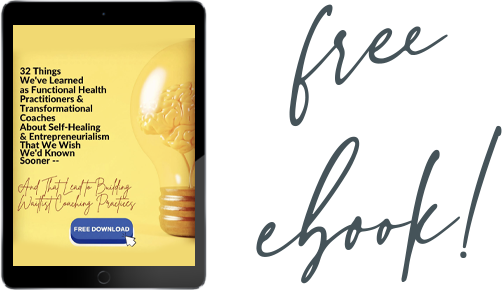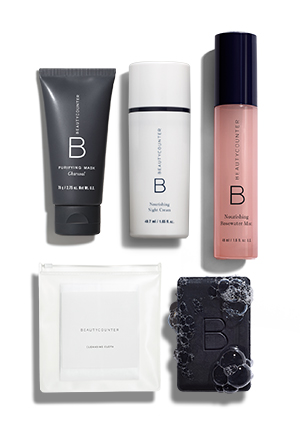16 July, 2022
Cell Danger Response: Is it Keeping you Sick and Tired?
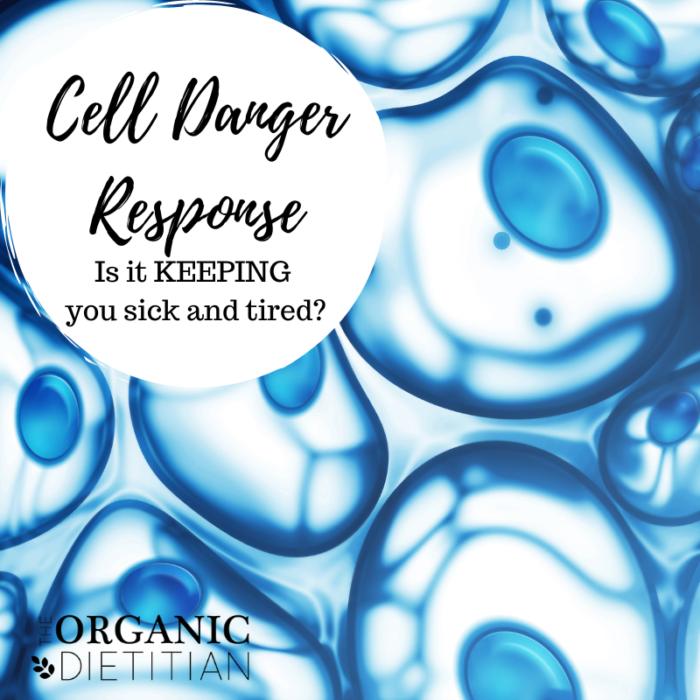
Are you constantly feeling tired or unwell?
Have you considered the health of your cells? Really, when it comes down to it, health begins at a cellular and tissue level, but then so does disease. We start to become dysfunctional at a cellular level long before symptoms even pop up (sometimes years or decades before). What is happening within our cells matters big time, especially if you are dealing with chronic health problems of any kind.
You may be in an extended state of cell danger response (CDR), which is essentially a state of chronic and excessive cellular stress when the body favors survival over thriving. Cell danger response inside the cells shifts cell metabolism away from growth and development and toward self-defense.
Symptoms that you might experience with a prolonged healing response from CDR include the following:
- Chronic Fatigue (CFS)
- Depression
- Brain fog/poor memory
- Poor exercise tolerance and a decreased ability to recover after exercise
- Chronic pain and inflammation
- Inflammation, edema, swelling, rashes
- GI issues
- Autism
- Hypothyroidism or Hashimoto’s
- “Adrenal fatigue”- Read More: You Don’t Have Adrenal Fatigue: What is Really Going On?
- Any autoimmune condition
- Metabolic diseases such as diabetes, obesity, high cholesterol, hypertension and heart disease
- AND MUCH MORE!
Haven’t heard of cell danger response? CDR is a topic rarely talked about, but important to understand as it can have a great impact not only on our health but on our ability to heal. Let’s dive in.
To discuss CDR and its role in chronic disease, we must first cover mitochondria.
Mitochondria
In a nutshell, mitochondria are the energy powerhouses of our cells. They are at the core of our health, energy, metabolism, and longevity.
They serve as batteries, if you will, powering various functions of the cell and the organism as a whole.
You might be asking yourself why mitochondrial function is relevant to a gut-healing specialist, but I promise you, there is a connection. After all, EVERYTHING is connected.
The role of mitochondria in the body
Environmental inputs directly influence mitochondrial function. This is a complex topic, so I’ll do my best to break it down. Mitochondria perform many roles inside our cells, but the two primary roles are:
- To convert nutrients from the food we digest, assimilating it into usable energy for our cells, known as ATP
- To monitor our environments (both inside and outside the body) for threat, danger, or harm
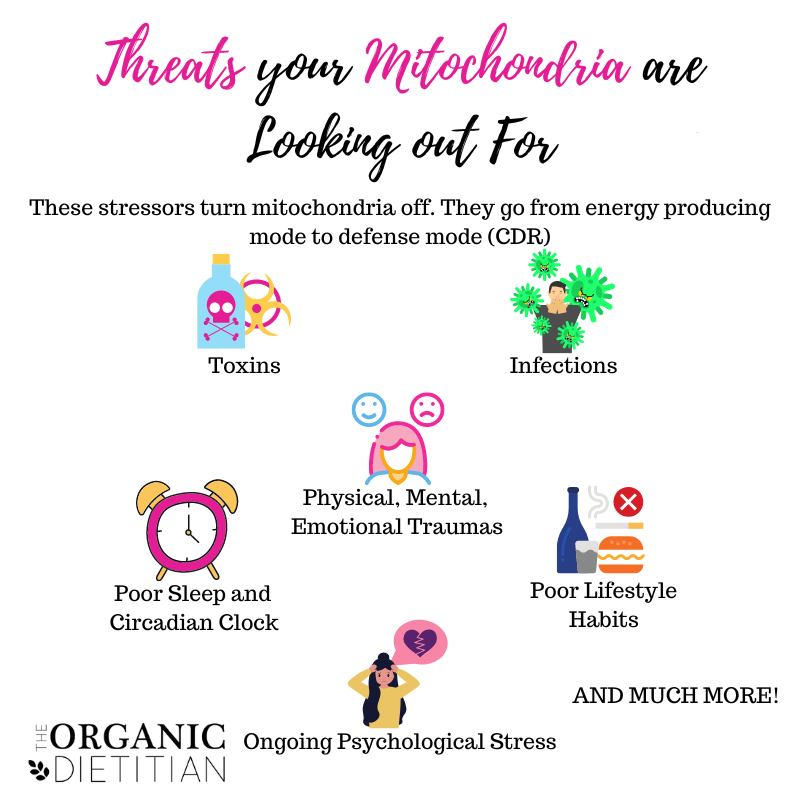
The “threats” your mitochondria are looking out for
When mitochondria sense a threat, they shift out of energy-producing and regenerative mode into defense mode; this defense mode is otherwise known as cell danger response.
Some of the “threats” include:
- Biological stressors, such as viruses, bacteria, parasites, and fungi, as well as nutrient deficiencies, nutrient depletion, hypoxia or low oxygen, inflammation, or oxidative stress
- Chemical stressors, such as heavy metal toxicity, chemical toxins, other toxins, and medications
- Physical stressors and trauma, such as accidents, injuries, burns, surgeries, and major infections
- Psychological stressors or trauma, such as divorce, loss of a loved one, emotional neglect, emotional abuse, major financial difficulties, and dealing with a chronic disease
- Lifestyle factors include a disrupted circadian clock, poor lifestyle habits, an inflammatory diet, and a lack of self-care.
How many of these might you be dealing with either currently or in the past?
For optimal health, it’s best to promote “peacetime mode,” a state in which your mitochondria don’t sense any (or few) threats. When unthreatened, our cells are able to perform their jobs and create a better environment for health.
What is CDR?
Now that you have a basic understanding of mitochondria, we can discuss cell danger response. It’s the complex defense used by individual cells to manage a danger or cellular threat.
It’s a way for the body to signal to other systems, organs, and cells that healing needs to occur or that “invaders” are present. It’s VITAL to resolve this response in order to feel vibrant and well and not inflamed, in pain, or fatigued!
In short, some form of stress (or stressors) activates the cell danger response and alters normal function, which, if prolonged and not resolved in a timely fashion, results in dysfunction. Dysfunction eventually results in disease.
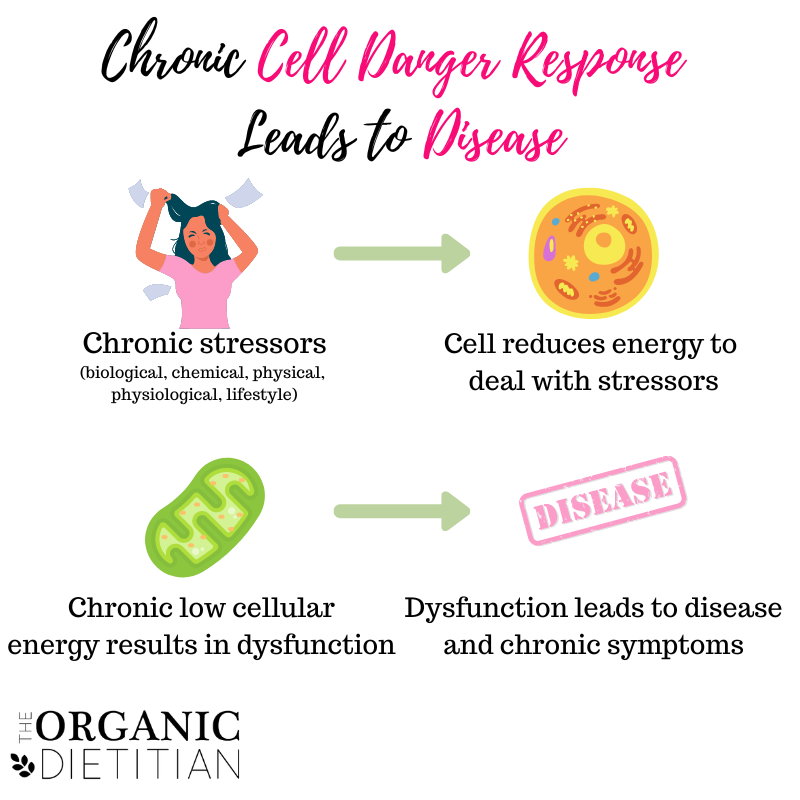
CDR isn’t ALL bad
Is CDR all bad? The short answer is… no!
For example, all forms of inflammation in the body aren’t bad. Acute inflammation is good and necessary for healing; it’s when the inflammation becomes chronic that it becomes a problem.
If you’ve ever had the flu, you know what the cell danger response can feel like. The body and mind shut down to help the cells do their work and eliminate the flu bug. Don’t you end up sleeping a lot when you are sick? This is CDR in action. Once the flu bug is gone, we feel better.
What’s the difference between this CDR experience and an unhealthy one? In the flu example, your cells went from healing mode back to energy mode properly. Just imagine if we get stuck in our body’s “healing” or “defense” mode—how would that feel? Tired and unwell, right?!
So, why does this happen? And what can you do if you realize you’re in this state?
When Cell Danger Response becomes a problem
The cell danger response (CDR) is a cellular response to threats that keeps an organism in healing mode at the cellular level. If threats persist, this can prevent the resolution of disease. Basically, when too many insults accumulate, the CDR can get stuck systemically in the “on” position, blocking healing and manifesting as a chronic illness.
However, healing can happen by properly identifying and addressing our personal root cause factors and by incorporating daily habits that help build health. Addressing CDR isn’t about just one factor. It isn’t just about killing bugs, running all the labs, or finding the right supplement protocol.
Turning off the Cell Danger Response
Improving your health at the cellular level and shifting out of CDR and back into an energy-producing mode to optimize health requires a multifaceted mind, body, and spirit approach. It takes time, patience, and fortitude! We didn’t get here overnight, so getting out of it will take radical action.
In order to switch off the cell danger, we need to first work on identifying as many stressors as possible that threaten our cells. Understanding the root of these biological, chemical, physical, and psychological stressors triggering an ongoing CDR and related health issues. Everyone’s stressors will be different and how many we have will vary. Working with a skilled practitioner on this is KEY.
Next, we need to work on building healthy daily habits that support our body at the cellular level. This means optimizing areas like sleep, movement, thoughts, nervous system regulation, nutrition, gut health, breath, mindset, blood sugar, and more! I work with my clients on these areas to develop support strategies.
There is no “one size fits all” solution. Let’s chat if you need guidance in finding your own step-by-step roadmap to healing, would like support, and are ready to take action! Book a breakthrough session below!
Other articles to check out: Is it Really Anemia? Root Causes of Iron Issues or Why Am I So Tired?




